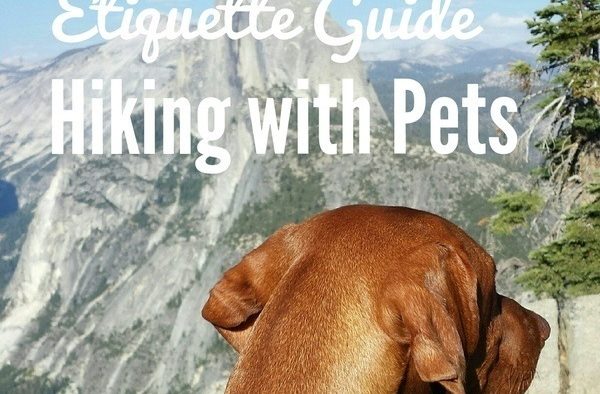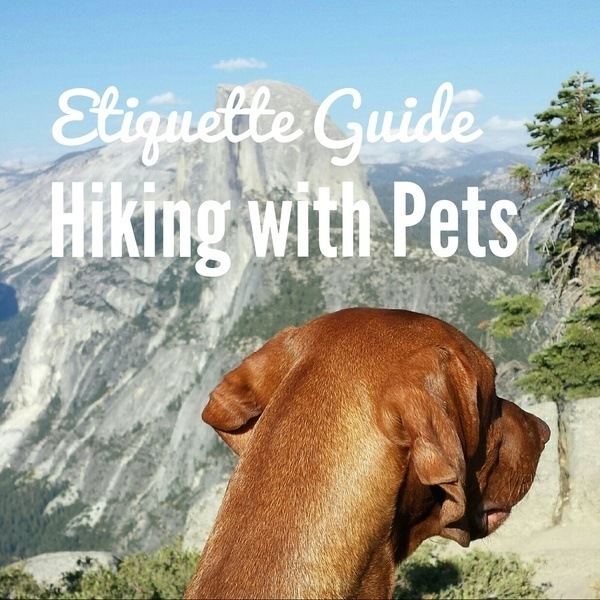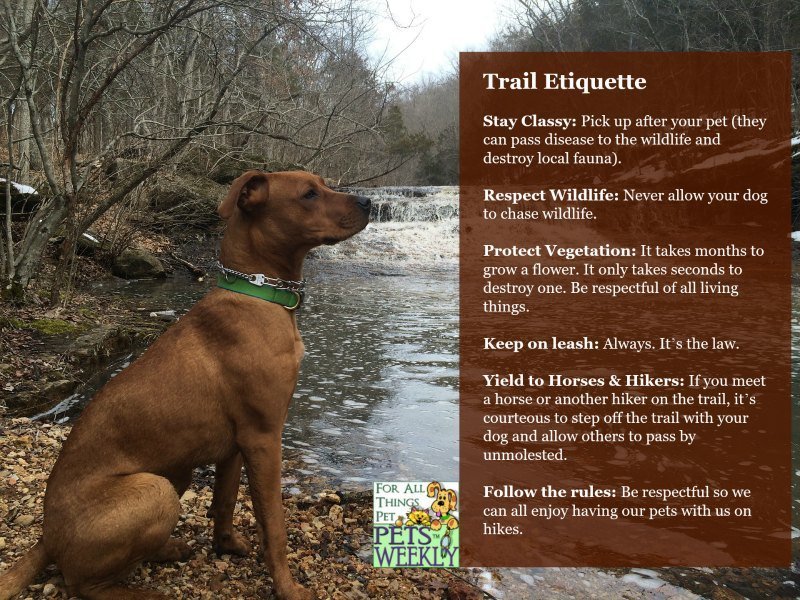Guide to Hiking Etiquette with Dogs
Share

 Cooler weather is on the way, and as the leaves change their colors to red and gold hues, it means many of us will be once again hitting the trails with our best four-legged friends.
Cooler weather is on the way, and as the leaves change their colors to red and gold hues, it means many of us will be once again hitting the trails with our best four-legged friends.
Let’s face it – nothing cleanses the soul like a relaxing hike through the wilderness. Whether you want to enjoy the rich colors of wildflowers in that remote desert valley, or just want to run a few miles through the pines, it’s important to make sure everyone out there has the same level of enjoyment as you do. So dust off the walking stick and renew your wild spirit, but make sure you follow trail etiquette when you take your pets along.
Dogs are usually naturals on the trailhead. That doesn’t mean you don’t have to watch them carefully – there are plenty of dangers in the wild – from poisonous mushrooms to cacti, and coyotes to rattlesnakes (not to mention hunters of the two-legged variety).
This is why it’s so important to understand the basics of hiking etiquette. Here’s a primer to get you started…
[heading style=”modern-1-light” color=”#006666″ style_color=”#006666″ align=”left”]Keep Pets Leashed[/heading]
This is now law in many areas of the country (on or off trail). Keep your dog under control at all time. Just because you’re a dog lover doesn’t mean that the person walking over that ridge shares your enthusiasm. Just because your dog is “small” or “wouldn’t hurt a rabbit” doesn’t mean they can’t get shot by a fearful person walking towards you. Leashes eliminate 95% of the problem.
[bt_taglinebox style=”full” width=”500″ font_size=”14″ text_color=”#5b5b5b” title=”Trail Tip” title_color=”#259b9a” align_center=”no” bgr_color=”#f6f6f6″]Most trail hikes within national forests require a park pass. You can pick yours up at any outdoor shop, the ranger station or by leaving payment in box at the site.[/bt_taglinebox][heading style=”modern-1-light” color=”#006666″ style_color=”#006666″ align=”left”]Yield Right of Way[/heading]
If you’re walking your dog, yield the trail right of way to larger animal. Is it law? No. Is it courteous? Absolutely. And if you’re wise enough to be out enjoying nature, I’m operating on the assumption that you’re smart enough to yield to larger animals. Some horses are “dog-shy” and your pet is just as likely (or more likely) than you to get kicked in the head if you don’t scooch over a bit.
Here are some common questions we get about hiking with pets:
[list icon=”icon: exclamation-triangle” icon_color=”#006666″]- If my dog is small, and a large dog is approaching, who moves? Personally, I would say the one with the most control over their pet should be the one to move. But assuming no one has common sense, the small dog owner should probably scooch a bit.
- If my dog is big, and a horse is coming, should I move? Yes. Absolutely. Not all horses like dogs and a frightened horse can cause far more damage than you being asked to move off trail for a moment.
- If my dog is crazy and a well-behaved dog is coming, should I move? Um, yes? But, a better question would be, “Why is your dog crazy?” Please stay at home until you’ve resolved the behavior issues.
[heading style=”modern-1-light” color=”#006666″ style_color=”#006666″ align=”left”]Respect Water Sources[/heading]
Water sources are rare in the Southwest, so this is a bone of contention with me. Don’t let your pet splash through the only clean source of water for miles (and you shouldn’t splash through either). This rule might be a bit more flexible in areas with running water or lakes, but if you come across a spring, keep paws out of it.
On that same note, dogs should not drink from unknown sources due to the danger of invisible parasites. Carry bouillon cubes or a small packet of dehydrated goat’s milk to encourage your pet to drink.

[heading style=”modern-1-light” color=”#006666″ style_color=”#006666″ align=”left”]Cleaning Up After Pets[/heading]
The only waste in a forest should belong to woodland creatures. You are visiting their home. Yes, bears do shit in the woods. It doesn’t mean you can let your dogs do it without picking up after them. Dogs can easily transfer disease to their wilder cousins and part of a happy life is making sure you take responsibility to keep all animals safe.
Clean up after your pets – if you bring it in, be sure you pack it out.
[heading style=”modern-1-light” color=”#006666″ style_color=”#006666″ align=”left”]Respect and Understand the Wildlife[/heading]
Just because your pets are enjoying their wild side doesn’t mean it gives them license to chase wildlife. Leave the bunny alone, don’t chase the squirrel, and for God’s sake, snake-train your pet if you’re hiking in the desert! Along the same line, you need to protect your curious canine from dangerous wildlife. These include, but are by no means limited to:
- Wild horses or burros (they are also protected by law, so if you see anyone harassing them, please report them to your local game and fish department)
- Wild cats: I’m talking cougars, puma, bobcats, etc.
- Wild dogs: Learn how to protect your home, your yard, and your camp from coyotes with this guide: Keeping Pets Safe from Coyotes
- Skunks:We have a whole guide devoted to skunks Eww, that Smell! How to De-Skunk Your Pets Safely and Naturally
- Porcupine: Another guide here Camping with Pets: Porcupines
- Snakes: Snakes are dangers that reside throughout the nation. Learn more about rattlesnakes here – Desert Dangers: Rattlesnakes
- Lizards: Lizards are not generally a problem for pets, but you still need to respect wildlife and not let your dog catch one.
- Toads: Bufo toads kill more dogs than rattlesnakes in the Southwest. Learn more about Desert Dangers: Toads
- Bears: Be aware of bears, particularly in the Spring.
- Spiders: Learn more about spiders at Spider Bites in Pets: Black Widows
[heading style=”modern-1-light” color=”#006666″ style_color=”#006666″ align=”left”]Know the Five Commands[/heading]
Come, Drop, Leave it, heel and Sit-stay are the five basic commands every pet should know before walking out the door. If your pets cannot do these things, you should focus your training until they can. We have a way for your to quickly teach these commands. Training Diaries: 5 Commands Your Dogs Should Know
Owning a pet is about being a responsible pet owner. You are responsible for teaching your pets good etiquette as they will not learn from others. Together we can make the world a better place for our animals and other humans.
[heading style=”modern-1-light” color=”#006666″ style_color=”#006666″ align=”left”]Announce Your Arrival[/heading]
No one likes animals running up on them, especially not in treacherous places like narrow trails, cliffs, or washes. It’s important to approach every person as if they are fearful of pets. Let the other make the first move. There are ways you can do that without being a jerk.
If you’re walking up on people or horses, call out that you’re “passing on the right”. Most people head to the high country to lose themselves in their thoughts, not have crazy animals run up on them. “Behind you” or “on your left” are also great notifications to those ahead of you.
When running or walking with your dog, it’s always polite to inform those ahead of you that you’re coming up behind. This can be done with a simple “Behind you” or “to your left” announcement letting them know you’re planning to pass. This is particularly important when using public walkways.
[heading style=”modern-1-light” color=”#006666″ style_color=”#006666″ align=”left”]Respect Plants and Animals[/heading]
There are hundreds of plants that can kill your pet in the forest or desert. Poison ivy, poison sumac, poison oak, stinging nettle, skunk cabbage, crocus, calla lilly, and tulips are just a few. Our biggest issue with plantlife is mushrooms.
Wild mushrooms kill hundreds of dogs each year. It’s very important you keep your pets away from plants. We’ll be discussing the dangers of mushrooms soon and give you some tips on types of wild plants you need to keep an eye out for. But, meanwhile, keep your dogs on leash and teach them the “drop” command sooner rather than later. It could just save their life.
[heading style=”modern-1-light” color=”#006666″ style_color=”#006666″ align=”left”]Prepare for Regional Diseases[/heading]
Your pets can become exposed to unusual diseases and viruses as fast as you can when you’re in a new area.These are the things you need to be aware of when hiking or camping with your pets.
Tick-born illness: Prevalent throughout the US.
Plague: This is still common in the Four Corners area of the Southwest.
Hantavirus: Also still around in the Southwest.
[box title=”What to Bring On A Hike” box_color=”#996633″]- Water: one gallon for you, 3 liters for each dog, per day. Dogs should not drink from unknown sources due to the danger of invisible parasites. Carry bouillon cubes or a small packet of dehydrated goat’s milk to encourage your pet to drink.
- Leash, collar and harness: Your pet should always be wearing a collar and proper ID tags. Keep dogs on a leash at all times.
- Bowls: Bring along a collapsible bowl for your dog’s water and food. They are lightweight and easy to clean on the hike.
- Picture ID: Be sure you have a recent picture of your pet in case the unthinkable happens.
- Waste bags: Make sure you can (and do) clean up after your pet.
- K-9 First Aid Kit: Be sure you have gauze (enough to wrap an injured paw), flex-tape, and antibiotic cream.
- Natural Pest Control: Be sure you keep your pet protected from mosquitoes, fleas, ticks, and other pests. There are many natural pest control sprays that will deter them from your pet (and you). Never use a spray intended for a human on a dog or horse.
- Pack: Your dog should never carry a pack that is more than 20% of his weight, but tasking your pet with a job is great way to tire them a little faster.
- Reflective Gear: Make sure your dog is never mistaken as a threat by ensuring they wear reflective gear.










